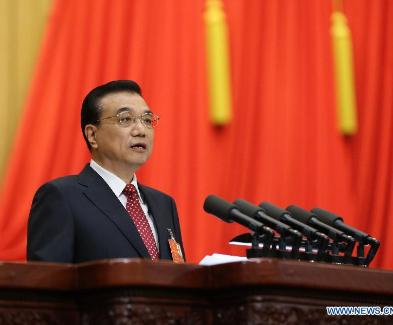BEIJING, March 7 (Xinhua) -- In 2016, the Chinese government plans to enhance openness of the country to the outside world, ensure beneficial cooperation for all parties, thoroughly promote the construction of the Silk Road Economic Belt and the 21st century maritime Silk Road /"The Belt and The Road"/. Such goals are included in the report on government work, which was delivered at the annual session of the National People's Congress of China (NPC) by Premier Li Keqiang.
The report explains the need to expand internal regional openness and develop international economic cooperation, jointly build economic corridors on land and establish control points for cooperation in sea transportations, strengthen interconnectedness in issues related to infrastructure, intensify trade and economic cooperation and humanitarian exchanges.
In order to simplify customs procedures, a customs cooperation mechanism will be formed between the members of the "The Belt and The Road" program, and international logistics highways will be created. Work on the creation of border and cross-border economic cooperation zones, as well as foreign trade and economic cooperation zones is in progress. By adhering to the principle of joint consultations, joint construction and mutual sharing, the Belt and the Road incentive will become a lane of peace and friendship and a way to common prosperity.
At first, "The Belt and The Road" Strategy became part of the Chinese government's work report in 2014. Last year, this program was again featured as one of the most important issues of reports. The idea to combine "The Belt and The Road" project implementation and extention of regional openness, along with the intensified construction of a new Asian-European transcontinental bridge and strong checkpoints on land and at sea was offered.
According to experts, after Chinese President Xi Jinping put forward the initiative to create "The Belt and The Road" during his visit to the countries of Central and Southeastern Asia in September-October 2013, difficulties are constantly overcome and significant results in the expansion of Chinese enterprises abroad along with the implementation of related construction projects are already achieved. Successful construction of large infrastructure facilities are particularly noticeable in this regard. All parties are full of expectations related to the development potential of "The Belt and The Road" Program and its excellent prospects.
Full-scale implementation of the "Belt and Road" strategy began last year. According to statistics provided by the Ministry of Commerce of China, investments of the Chinese enterprises from 49 countries along "The Belt and The Road" totaled $14.82 billion in 2015, i.e. 18.2 percent more then a year earlier. Most of the investments were directed to Singapore, Kazakhstan, Laos, Indonesia, Russia and Thailand.
Experts also note that the foundation of the Asian Infrastructure Investment Bank/AIIB/ and the Silk Road Fund can be a guarantee of even more powerful and broad support for "The Belt and The Road" construction. The AIIB officially started operating this year in January. As an effective financial institution, the bank will support the construction of infrastructure facilities within the framework of "The Belt and The Road Program", and states participating in the construction will get an opportunity to establish even closer business and diplomatic relations.
The Silk Road Fund has been operating for more than a year, during this period it has directed investments in infrastructure, energy resources and electric power industry, metallurgy, communications and other economic sectors of the countries located along "The Belt and The Road".
Last year, when the full-scale construction of "The Belt and The Road" began, the first results have already been obtained. Thus, as of December 2015, Chinese Ministry of Commerce has concluded interdepartmental agreements on cooperation in the joint creation of the Silk Road Economic Belt with eight countries of the Eurasian region. In the Eurasian countries, to the extent of strengthening interaction and cooperation in terms of production capacities, an important highways, cross-border logistic routes, energy infrastructure facilities, as well as foreign trade and economic cooperation zones have been already created or are under construction now.
In particular, the reconstruction of the ring road around Issyk-Kul lake is currently underway, the Datka - Kemin power line in Kyrgyzstan has been built, construction of the Aini - Panjakent highway in Tajikistan has been completed, also construction of the Kamchiq Tunnel on the electrified railway line Angren - Pop in Uzbekistan and tunnel on the Vakhdat-Yavan railway line in Tajikistan are also progressing well.
As for trade cooperation, in 2015, China and Georgia formally started negotiations on free trade agreement. A SCO trade facilitation working group has been created, other trade assisting mechanisms are being actively promoted, cooperation talks with the Eurasian Economic Union are under way, and lofty agenda for the creation of free trade zones are also outlined.
Chinese government work report for the current year notes that in the period 2016-2020 it will be necessary to reach significant progress in "The Belt and The Road" construction and make a breakthrough in international cooperation in terms of production capacity. According to experts, in the future "The Belt and The Road" program will play even greater role. The strategy implementation has just begun, and thanks to strong governmental support, this project will continuously develop in order to meet the needs of the whole world.
Source: russian.people.com.cn
Write to us
Write to us
- 5 Sovetskaya str., Block A, Novosibirsk, Russia
-
